Mythbusting 101 - Lesson Three
2006 03 21
From: metahistory.org
Article recieved from Light Eye
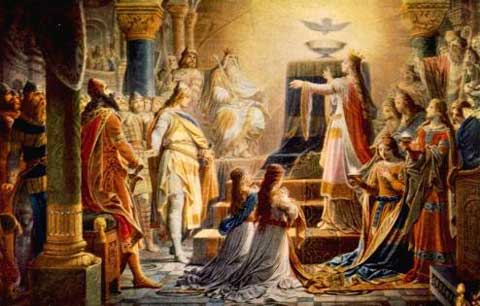
"The Miracle of the Grail" By Wilhelm Hauschild, Neuschwanstein Castle, Bavaria.
Parallel History in Europe and the East
To confront the Paternal Lie requires a number of aikido moves,
set out in these lessons in Mythbusting 101. In the first place,
the core beliefs imposed by the patriarchal dominator agenda
have to be exposed: for instance, the belief that the Father
God conveyed his commands to bearded male emissaries who in turn
codified them into rules for personal and social behavior. Men
who speak for the Father God and rule in His name are theocrats.
They may not openly assert their descent from divine origins,
but let's not be fooled by false modesty. True, the age-old
claim, popular from pharaonic Egypt down to the time
of Louis
XIV, to be descended from the gods does not play too well in
post-Enlightenment times . But old myths die hard. You can be
sure that somewhere, somehow, theocrats of today cherish the
belief that they have a privileged connection to the Creator — ideally,
a genetic connection. The family of George W. Bush jokingly refer
to him as "the Chosen One."
Or maybe it is not a joke.
The script for divine kingship originated with the Annunaki
scenario found on cunieform tablets dating from 1600 BCE, but
preserving
a much older story. The Babylonian creation myth, the Enuma
Elish,
begins, "And kingship descended from heaven..." At the dawn of
the Christian
era, this
script became conflated with the figure of Jesus
Christ, imagined
as
the immortal,
God-sent
savior.
From the time of Alexander onward, some Roman emperors declared
themselves divine, but the emperor Constantine proved more clever
than any of them: he had Christ declared divine (by forced
vote at the Nicean Council of 325 CE), then he declared Christianity
to be the state
religion of the empire he ruled. Doing so, he underwrote his
imperial authority by divine authority. And he did not even have
to belief in the Savior to do it. (Most historians conclude that
Constantine's "conversion" was staged, if it ever happened at
all. Even Constantine's personal historian, Eusebius, admitted
to fudging the story to make the Emperor look good.)
These may seem like paltry antiquarian
issues, but they are far from it. The Annunaki model of
theocracy, now intimately linked to salvationist faith, is still
alive and well
in the year 2006. In fact, it is thriving among Jews, Christians,
and Muslims
alike, although in rather different versions.
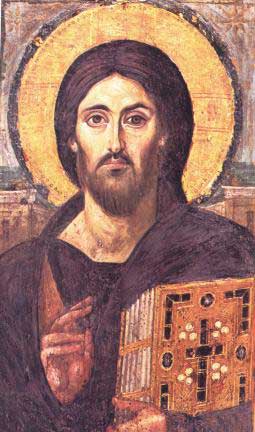 The
commanding image of Christ Pantocrator represents the apotheosis
of sacred kingship: the Son of God who rules the world. Such
is the supreme historical ideal of Christendom. But squint a
little, and it is easy to see this same figure as a Muslim
imam
or bearded ayatollah clutching the Koran. (Christ Pantocrator,
Monstery of St. Katherine, icon on wood, 6th C.)
The power of
salvationist faith relies heavily on schizoid logic. In the
mind-boggling concept of trans-worldly power that
rules over this world and, operating from beyond time, decides
the outcome of history itself, the
theocrats have a potent tool for behavioral programming.
The
commanding image of Christ Pantocrator represents the apotheosis
of sacred kingship: the Son of God who rules the world. Such
is the supreme historical ideal of Christendom. But squint a
little, and it is easy to see this same figure as a Muslim
imam
or bearded ayatollah clutching the Koran. (Christ Pantocrator,
Monstery of St. Katherine, icon on wood, 6th C.)
The power of
salvationist faith relies heavily on schizoid logic. In the
mind-boggling concept of trans-worldly power that
rules over this world and, operating from beyond time, decides
the outcome of history itself, the
theocrats have a potent tool for behavioral programming.
Theocracy is the supreme goal of the Abrahamic religions. Right-wing
Christian politics in the USA does not differ from the ideology
of imams, ayatollahs, and Muslim clerics who insist that Islam
makes no distinction between religion and
politics. The neo-cons around President George Bush were trained
in ideological strategies by Jewish historian Leo Strauss, the "godfather" of
American fascism. Strauss espoused the Illuminati principle of
the "noble lie," originally stated by Plato. It is
more than likely that Bush was advised by Strauss protegés
(such as Paul Wolfowitz) to openly declare that his religious
convictions guide his politics. Doing so, he could thumb his
nose at the
Muslim
world,
sending
the signal that he is as righteous as any ayatollah, if not more
so. The President's declaration of faith has been extremely provocative
to Muslim sensibilities. His pious posturing provokes the worst
in Islam — just what it is intended to do
Parallel History
"While religious people are not generally mad, their core beliefs
absolutely are." Sam Harris, The End of Faith
Vehement hatred of Israel is rampant throughout the Arab world.
Daily papers and television in all Muslim countries seethe with
vilificaton of the Jews and rabid calls for the annihilation
of Israel. As Sam Harris observes, "anti-Semitism is intrinsic
to both Christianity and Islam; both traditions consider the
Jews to be bunglers of God's initial revelation." All three
theocratic ideologies spring from the same root; all three are
infected with the same pathology; all three rely for their continuance
on faith-based violence. One quarter of the world's six billion
people are
Muslims,
another
quarter
are
Christians,
and the precarious hinge between these massive (and rapidly growing)
factions is Judaism. The hinge is jerry-rigged so that Christians
can
swing both ways, for and against the Jews. In political terms,
the Christian USA is united with Israel against the Arab world.
In spiritual terms, Christians reject the Jews for denying and
murdering the Son of God. All three religions are "People
of the Book," but Muslims insist that they and only they
have the Book that will save the world from the decadence
of the West..
The violence generated by this three-way dynamic guarantees
that peace is not an option as long as faith rules the planet.
But in Europe, faith does not rule. This is because the European
West is heir to another history, a secret history concealed within
the violence-ridden scenario of theocratic religion. Little is
known of this alternative history, but it is not difficult to
discover, once you know how to look for it. In modern times,
this hidden history comes to light through the values and attitudes
it has produced by a long and troubled maturation — the
heritage of secular humanism, as it is called. As Europe observes
the standoff of fundamentalist ideologies, politicians in France,
Spain, Germany, Belgium and elsewhere attempt to keep their distance
from religious rhetoric and faith-based realpolitik.
Early in the first term of George W. Bush, Belgian president
Guy Verhofstadt stated on the evening news that if he were to
mix religious and political views in the way the American president
does, he would immediately be committed to an insane asylum.
The merge of religion and politics is anathema in Europe because
Europeans have learned the hard way that theocracy promises social
reform, and spiritual deliverance, in order to enforce a
doomsday program. Ravaged by religious wars for centuries, Europeans
know better than to take a road that always leads to
social chaos and material destruction. Many of them who still
retain some
religious affiliations in private life stand aghast before the
current scenario, the "conflict of ideologies" that
endangers the entire planet. The outlook of secular humanism applied
to the political world allows Europeans to keep some distance
from the problem, but does not provide a solution
to it. (In
fact, from its inception in the Renaissance humanism failed to
deliver on its promises - but this is another lesson in Mythbusting
101.)
To defeat the Paternal Lie, we must disengage from the
historical scenario driven by theocratic imperatives and tap
into the hidden resources of a parallel history. The
Lie succeeds by enforcing the master plot of the Father God's
PLAN for humanity. To achieve this plan means ultimate vindication
for Jews, superhuman salvation for Christians, and totalitarian
control of society for Muslims — but there is a parallel
history of the West that liberates us from complicity in these
perverted, genocidal programs. Unconditionally disowning
what the Father God plans for humanity is not an option
that is generally regarded to lie within the humanistic scheme
of values, but humanism paved the way for such an option. But
the belief that the plan for humanity comes from the off-planet
male
deity
who
created
us, as the Biblical charter story of theocracy
says, cannot be rejected unless there
is another story to take its place. The humanist tradition
in Europe contains the vital threads of such a story: the Quest
for the Grail.
Contrary to what some bad-boy French intellectuals hankering
for a spanking would have us believe, the human species cannot
live without a master
narrative of some kind. The story to guide the species must combine
mythopoetic and historical elements. However the human species
may have emerged in the cosmos — this is the part of story
to be discovered and developed through mythopoesis, along Gaian
lines — those who aspire to create a humane world here
and now must count on what has brought the human race to
it current sense of humanity. As I've said before, resorting
to a metahistorical sound-byte, prehistory is what made us human,
and history is what we have made of being human.Through history
we come into a sense of humanity — not to assume, however,
that it was lacking in prehistorical people. No, they (this is,
we in far-distant times) had great humanity, but it was implicit,
whereas the main effect of the
drama of history is that it puts the issue of humanness
right in our faces.
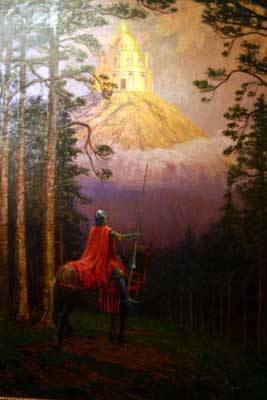 The opening word of Parzival is zwivel, doubt, and
the recurrent motif of the legend is vragen,
questioning. The hero swivels precariously on his sense of humanity,
and puts into question all faith in the guiding hand of God.
He even declares that he hates God. Parzival exemplifies the
modern historical
self
caught in the existential dilemma of being human without an
essence, a predetermined spiritual criterion that defines humanity.
Yet he is drawn toward a spiritual calling that would allow him
to alleviate the suffering of humanity. Although it is his fate
to gain access
to
a supernatural wonder, he cannot and does not rely on a higher
power to find his way to it. Life itself shows him the way.
The opening word of Parzival is zwivel, doubt, and
the recurrent motif of the legend is vragen,
questioning. The hero swivels precariously on his sense of humanity,
and puts into question all faith in the guiding hand of God.
He even declares that he hates God. Parzival exemplifies the
modern historical
self
caught in the existential dilemma of being human without an
essence, a predetermined spiritual criterion that defines humanity.
Yet he is drawn toward a spiritual calling that would allow him
to alleviate the suffering of humanity. Although it is his fate
to gain access
to
a supernatural wonder, he cannot and does not rely on a higher
power to find his way to it. Life itself shows him the way.
In his zwivel, Parzival senses that he has been betrayed
by God. This sense of betrayal is in reality the first indication
of his dawning faith in humanity itself, his humanistic criterion.
Just because he doubts God, Parzival is a leading exemplar in
the parallel history that can free
us
from
the Paternal
Lie
and
lead
beyond
the genocidal
and ecocidal programs through which the proponents of the Lie
claim to be accomplishing the will of the Father
God.
The hidden history of the three currents proceeding from the
Grail is not His story, not the self-legitimating narrative of
the off-planet creator. It is our own species-specific legend,
the tale that tells how we have come to know what it means to
be human. This tale begins with the prehistory of the human
species and Gaia, the living planet. The prehistorical scenario
tells what made us human in the first place. By contrast,
the historical scenario tells what we have made of being human,
as just noted. Some hints of the former scenario can be found
in Tree
Nymphs and Tree-Hung Shamans and other mythopoetic material
on site. The lessons in Mythbusting 101 concern the historical
dimension of our story, rather than the prehistorical and
mythic dimensions. This is the narrative that can guide
us toward a generic feeling for the human species, a sense of
humanitas.
Consistent with the foundation essay, Children
of the Damned, I will use the word humanity for
biological definition of the human species, and humanitas for
the intuition of what it means to be human in the moral and
spiritual sense, and to act humanely.
Social Enlightenment
As we have seen, the passing of the Grail from Parzival to Lohengrin
was a turning point in the development of humanism in the
Western world. Even though it failed as a philosophical program,
Renaissance humanism defined the need for a generic intuition
of humanitas, including such essential marks as dignity of
the individual and universal rights. It opened
a brief window of opportunity for social enlightenment reflected
in philanthropic ideals. The humanistic zeitgeist matured
slowly from the 10th to the 15th century. Lohengrin modelled
a new social equation in which a fated couple from the realm
of privilege dedicated themselves to social reform, defending
the right of common people to live in a decent and humane way.
In this way, those who were better off in life could make life
better for those who weren't. The unique condition of the new
equation required that the couple not reveal their privileged
origins, so that the benefits of their efforts did not accrue
to the patriarchally founded (and funded) class from which they
emerged. In this way, the Lohengrin principle counteracted, or
at the least neutralized, the self-rewarding ethos of dominator
society.
A noble and wonderful prospect, it seems. It must be said, however,
that the new social equation prefigured in Lohengrin was not,
and is not, the only humane and generous way to contribute to
the betterment of society. It is one model of social enlightment,
but not the exclusive model, and perhaps not even the paramount
model. To this day, many privileged people engage in philanthropic
activity
that
does not follow the Lohengrin principle. Untold good has been
done, and immeasurable improvements in society have
been accomplished by those who embrace and practice what Buddhists
call "the altruistic intention." This intention is
inherent to the Bodhisattva vow, but the practice of renouncing
merit — reflected equally in the Lohengrin model and Buddhist
ethics, as explained in Lesson Two — appears to be a special
option, not an essential condition, of socially
enlightened activism.
In short, there appear to be two ways of pursuing social betterment:
by working within patriarchy, and by working beyond it. In the
first case, merit for acts of social enlightenment accrues to
the privileged classes who pursue it: for example, philanthropists
receive huge social acclaim and cascading material benefits for
their actions. In bettering the world, they always end up better
off themselves. They do not engage in any altruism that would
risk their privileges. But in the second case, such merit is
relinquished and another kind
of social
dynamic
comes
into
play.
The Lohengrin principle involves this other dynamic, far
less likely to be embraced by the privileged classes. Occasionally,
this dynamic flashes up in moments of great social unrest — for
instance, the Decembrist revolt in Russia in 1825, when aristocratic
soldiers in hereditary service to the Czar broke their allegiances
and sided with
the populace against the empire — but they always fail.
Even when represented as operatic kitsch, the story of Lohengrin
carries
a deep, inescapable pathos, for it points to a
doomed ideal.
But the passing of the social mission linked to the Grail to
Lohengrin does not exhaust the magical, life-changing capacity
of the Grail.
The First Grail Question
Let's return to the climactic moment of the Grail Legend, when
Parzival asks the question. Although it is not clear from Wolfram's
version alone, there are two questions involved in the Legend.
The first one, "Humanity, what ails thee?", directs
us to the suffering inflicted on the world by those who are themselves
deeply wounded. In other words, those who are wounded in
their sense of humanity, wound and afflict the rest of humanity,
physically, karmically, and otherwise. Parzival addresses this
question to the wounded Grail king, Amfortas, the key patriarchal
figure of the Grail Quest. It is crucial to understand that Parzival
directs the question about suffering to the one who suffers.
but who can neither die of the affliction, nor be permanently
cured of it. Doing so, he confronts the pathological evil of
the Paternal
Lie at
its
source.
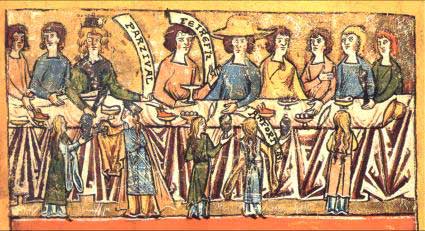
The Grail Legend is a family affair, but not exclusively so. For Parzival, knowing his personal history and the source of the paternal affliction freed him from family conditioning. (Munich Parzival ms., Cgm 19, showing Parzival, Fierefiz, and Amfortas, identified by lettered banners.)
Parzival's action is paradigmatic, as Mircea Eliade would say.
It sets the example for all of us. The Quest teaches that in
order to face the suffering of humanity at large, we each must
address the wounds carried by people in our personal lives, especially
parental figures. This is not to say that we reconcile with patriarchy
or submit to
parental
authority and its codes and imperatives. Not at all. The Quest
does not teach us to honor parental conditioning, but how to
transcend it. To go beyond familial conditioning, we must look
deeply into what it is, where it originates, and how it harbors
a self-perpetuating pathology (codependency, in pop psych jargon).
We must talk directly to the wounded paternal forebear about
his suffering, for what he suffers is paradigmatic of the human
species. In asking his uncle the first question, Parzival confronted
the suffering inherent to his family situation. Through
that confrontation, he came to terms with universal suffering.
Buddha's assertion that "all is suffering" — sarvam
dukkham — is compatible with Parzival's first question.
Eastern and Western wisdom are entirely consonant on this issue.
We are all deeply implicated in the wound of the Fisher King,
the fatal affliction of patriarchal society. As long as the Grail
family was isolated in the Wasteland, and the knight destined
to ask
the question had not yet done so, the family could continue to
live from the rich resources of the Grail, but Amfortas could
not be healed by the Grail, and those who were served by it could
not offer its service to others. All this changed with the passing
of the Grail to Lohengrin. What does this narrative tell us about
the alternative history of the West? It indicates that at some
time in the 10th century, a shift in the social life of feudal
Europe allowed the noble intention of altruism to emerge in
the privileged classes, and this shift led eventually to the
birth of humanism in the 15th century. During those five centuries
of transition, historical events reflecting the Grail Legend
transpired in the Lowlands where the Lohengrin story is set.
In fact, several late medieval sources relate that the Grail,
considered as a physical relic, was taken to Bruges in central
Belgium. There it was kept, preciously guarded, during the Flemish
Renaissance.
Humanism dawned in the Lowlands where the Grail was guarded
at Bruges, the Venice of the North.
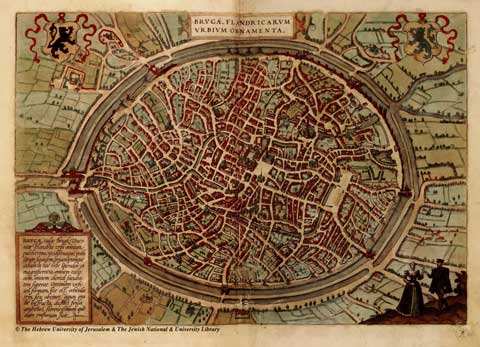
Map of Bruges, 1572, Braun and Hogenberg
Today Bruges is little more than a Disneyesque tourist trap,
but this medieval city with its charming canals populated with
wild
swans still exudes a mysterious aura that does not go unnoticed
even to the unenlightened tourist. Like other cities in Belgium,
Alsace and Germany, the town of Bruges traditionally celebrates
the metiers or trades, such as shoemaking, tannery,
tapestry, beer-making, iron-mongering, and so forth. The trades
were occupied by working class people whose employment and rights
depended on the privileged classes, consistent with the Lohengrin
principle. Each trade had its heraldic emblem, imitating the
heraldry of the Nobility. The point was so show that the nobility
of decent labor was complementary to blood-based
nobility. The medieval trade-guilds inspired the original trade
unions or syndicats of Europe. True European socialism
grew from the humanistic legacy of the Grail, reflected in the
guild system. The system depended on
a contract of honor and trust between the privileged classes
and
the common
people
who worked for them.
Now, we might well wonder, How could the Grail have been kept
in Bruges in the 12th Century when it had been taken to India
by Fierefiz in the 10th Century? Well, as many people have noted,
there is not one single Grail, but a variety of Grails or facets
of the Grail. From the 12th century onward, the Church of the
Holy Blood in Bruges boasted a chalice containing drops of Christ's
blood
that
acted
in miraculous
ways, as such relics are said to do. This shameless Christian
flummery disguises the presence of a genuine Grail in the Lowlands
in the centuries after Wolfram wrote Parzival. The genuine
Grail preserved at Bruges was the impulse of social enlightenment
modelled by the proto-humanist hero, Lohengrin.
The Grail that went to India and then Tibet was the ritual-liturgic
expression of the original magic. It comprised a formula of cosmic
timing, the lunar writing on the Grail that plays such a crucial
part in the legend, and the psychodynamic practice of the Wish-Fulfilling
Gem.
The Asian Grail Trail
There are a number of interesting parallels
between the myth of Shambhala and the legend of the Holy Grail.
- Edwin Bernbaum, The Way to Shambhala.
In the far East, the Grail magic became formulated into the
Kalachakra system, and, at the same time, it was internalized
into the Wish-Fulfilling Gem, a yidam or magical image
used in the "development stage" of Ati Yoga (Dzogchen).
These are two remarkable instances of cross-fertilization between
West and East.
The key Asian figure in the Kalachakra tradition was the monk
Atisha (982 - 1054), a younger contemporary of Parzival and other
characters in the hidden historical scenario of the Grail. Atisha's
guru was Pindo who came from Java in the southern ocean. Honorifically,
Pindo was called Kalki Shripala, the mystical figure "who
introduced the Kalachakra tantra during the second half of Mahipala's
lifetime," according to Taranatha's History of Buddhism
in India. Mahipala was a Pata king who reigned from 988
to 1038. This historical fact is closely linked to the quasi-historical
legend of Shambhala, because Kalki Shripala was one of the legendary
regents of Shambhala, the mythical realm with which Prester John
is associated.
(See The Wheel of Time: Kalachara in Context by Geshe
Lundrop Sopa, Roger Jackson and John Newman, p. 72 ff.)
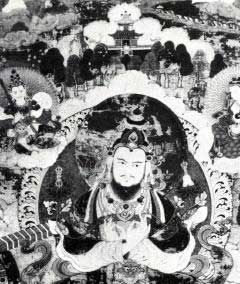 Kalachakra
practices involve closely guarded knowledge of cosmic and planetary
time-cycles, divinations, and "mastery of the psychic powers" (The
Wheel of Time, p. 75). One of the first known masters of
the system was Naropa, who died in 1030 AD. His guru, Tilopa,
was probably born in 988 AD, close to the moment of Parzival's
attainment of the Grail, if we place the historical reflections
of the Legend in the 10th Century. In The Life and Teachings
of Naropa, H. V. Guenther devotes quite a lot of time to
explaining the Wish-Fulfilling Gem which played a key role in
the yoga system of Naropa. (Sucandra, the first King of Shambhala. The Way to Shambala, plate 5.)
Kalachakra
practices involve closely guarded knowledge of cosmic and planetary
time-cycles, divinations, and "mastery of the psychic powers" (The
Wheel of Time, p. 75). One of the first known masters of
the system was Naropa, who died in 1030 AD. His guru, Tilopa,
was probably born in 988 AD, close to the moment of Parzival's
attainment of the Grail, if we place the historical reflections
of the Legend in the 10th Century. In The Life and Teachings
of Naropa, H. V. Guenther devotes quite a lot of time to
explaining the Wish-Fulfilling Gem which played a key role in
the yoga system of Naropa. (Sucandra, the first King of Shambhala. The Way to Shambala, plate 5.)
The Arthurian equivalent to Shambhala is Avalon. Pagan revivalist
Gareth Knight compares the vigils and adventures of medieval
knights like Parzival and Gawain to Asian yogic practices, especially
Tantric rites involving the serpent power, Kundalini. He argues
that Arthurian chivalric lore, in some respects, at least, presents
evidence of "the yoga of the west," although "this
knowledge had not been adequately expressed in terms of the Western
Mystery Tradition." (The Secret Tradition in Arthurian
Legend, p. 128 and 187). Knight also notes that "the
ancient Mysteries of the immediately pre-Christian era were one
of brotherhood in more ways than is currently realized" (p.
56). This observation is consistent with Wolfram's story in which
we meet knights from all corners of Europe, from Iceland to
North Africa, not to mention the extension of the chivalric order
into
the Near East, and beyond.
The extraordinary cross-fertilization effected by the 10th Century
passage of Grail magic to India is central to the plot of parallel
history.
Gandhara and After
It is, of course, natural to wonder about direct contacts and
exchanges between East and West — for instance, Did a Syrian-French
member of the Grail family go to India around 1000 CE and meet
Buddhist mystics such as Atisha, Tilopa, and Naropa? While
textual evidence of such contacts does exist, such evidence
is not the final proof of the truth of our story. The evidence
is merely anecdotal, but the proof is in how we, here and now,
connect with the pattern of events that comes to be revealed
as we recognize
and own the parallel history.
Many exchanges and contacts between East and West happened along
the Asian Grail trail that led from Europe to Ghandara and then
forked down into central India and northward into Tibet. Greek
and Buddhist art and philosophy merged in Ghandara in the Hindu
Kush after the expeditions of Alexander the Great. Historical
evidence of contacts survives from the reign of Asoka, who sent
Buddhist missionaries to Egypt. In the Reading Plan for the Nag
Hammadi codices, I argue that the Book of Thomas the Contender is
not a Gnostic work at all, but a Buddhist sermon on transience
and desirelessness, likely to have been imported to Egypt via
Ghandara.
Nagarjuna, the Buddhist teacher of Madhyamika, the
Middle Way, taught at Nalanda University in the 3rd Century
CE when the Mysteries first came under fire from Christian ideologues.
His Gnostic contemporary Basilides
used an idiom of thought that is almost indistinguishable from
Madhyamika.
Passages in Eugnostos the Blessed (NHC III, 3 and
V, 1) could pass, line for line, for Nagarjuna's deconstructive
discourse. It is more than likely that Buddhist scholars such
as Nagarjuna taught in Alexandria, and, vice versa, that some
Levantine Gnostics went as visiting scholars to the far East.
It is difficult to place Gnostics geographically, just as it
would be difficult today to place "deans" geographically.
Deans are tenured professors found throughout the widespread
university system, including the ivy league colleges. Likewise,
the gnostokoi were tenured specialists in spiritual
matters who taught in many Mystery schools throughout Europa,
North Africa, the Levant, and the Near East. One of the strongholds
of Gnostic learning was Antioch in Syria. Let's recall that Gahmuret,
Parzival's father, was a French knight living in Syria on lands
ruled by the Anjou or Angevin dynasty.
Tracing the Asian Grail trail, Joseph Campbell says that an
Arabic translation of the Sanskrit Panchatantra appeared
in Syriac in the 10th century. The more one looks into this matter,
the more it becomes evident that "the passage of literary
matter in the Middle Ages from India to Europe was considerable" (Creative
Mythology, p. 419.)
Simultaneous Events
So, there is ample evidence that Asian-European exchanges took
place from the time of the Greek-Buddhist fusion in Ghandara,
around 350 BCE, and continued into the 10th Century when the
story of Parzival transpired. That is well over a thousand years.
What is to be remarked in all this detail is simultaneity.
The alternative history that leads beyond the Paternal Lie is a
global story in which interwoven events happen at the same
historical moment in different parts of the world. Such events
are not normally included in the sequential historical record
used by patriarchy to record and legitimate its faith-driven
agenda of domination.
In alternative history, events that happen simultaneously are
far more significant than events that unfold sequentially. As
the vehicle of the Father God's plan for humanity, mundane history
is a chronological account of events transpiring in sequence,
and presumed to proceed by cause and effect —"just
one damned thing after another," as Henry Ford tartly observed.
But the hidden dynamic of alternative history is neither causal
nor sequential. Chronological events may be symptomatic of
the deeper, hidden pattern, but they do not determine it. What
then does determine the flow of the "infrahistorical" plot,
conceived in alternative terms? It is the success or failure
in defining and actualizing humanitas as it emerges, moment by
moment, age after age, always exhibiting a new profile with unique
challenges and lessons to be learned, always presenting another
chance for novelty, innovation, and higher adapatation.
By contrast, the chronological record of history over the last
6000 years shows a trajectory of increasing
maladapation due to dominator cultures that overrule and repress
more egalitarian, ecocentric ones. As urban civilizations arise,
systems of social
and behavioral
control
proliferate, and life complexifies, leaving people with more
options and less judgement to make choices in a life-affirming
way. Concurrently,
human
potential
degenerates and the earth suffers increasing degradation that
turns some areas into human-made wasteland. (The ongoing decline
of humanity, by contrast to ascent and progress,
is the dominant motif of all indigenous systems of timekeeping.
In suggested reading for themes, see Richard Heinberg, Memories
and Visions of Paradise for examples.)
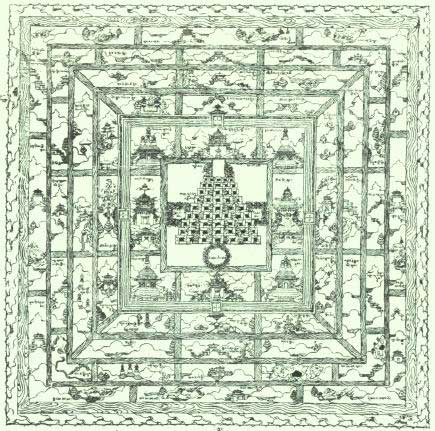
Along with secret time-cycles, parallel history involves magical
places that are linked, though never entirely identified, with
geographic locations. Shambhala is such a magical place, but
that does not preclude its being a physical place as well. According
to Tulshi Rimpoche (cited by Bernbaum), the spectacular saddled
peaks of Kangtega in the Himalayas are said to be a gateway to
Shambhala. In Asian and Western folklore alike, terrestrial geography
offers entry-points to the Otherworld. The prototype
of Arthur's Avalon was Tir-na-Nog, the land of the Dreamtime
in Celtic myth. Likewise, the Buddhist kingdom of Shambhala had
its prototype in Bon religion. The hidden counntry of Omlolungring
(shown above in mandala form) exists in the Otherworld and, simultaneously,
interfaces with the physical world. A magical tower of many levels
figures in Gawain's adventure in the land of the sorcerer, Klingsor.
Both the Bon and Arthurian images do not represent imaginary
places, but facets where imagination allows the passage from
the physical world into other, inter-nested dimensions.
Visiting the places associated with magical locales, such as
Kangtega in Asia or Tintagel in England, tunes the mind to the
constant frequencies of the Legend. Parallel history is best
remembered in these places, preserved in the memoria naturae,
the memory of the earth itself.
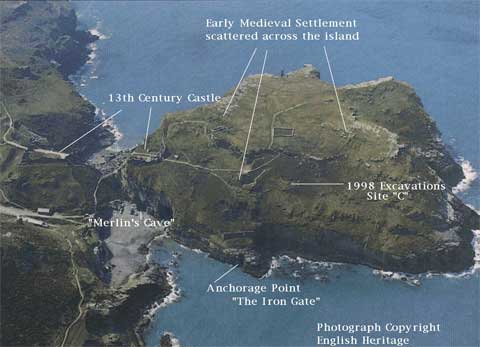
Tintagel, England. Source: gla.ac.uk. See: more images.
The alternative history of humanity is a kind of planetary
folklore, a narrative of immense participatory appeal,
not excluding touristic appeal. Its power does not
reside in the predetermined certainty of the unfolding of God's
plan
in historical time, but in our intimate and voluntary participation in
the self-actualization of the human species, defined and developed
exclusively on human terms. For humanity there is
no divine plan, but there is a process of self-direction that
surpasses
any
plan. However, it takes a master narrative to engage the human
imagination with the self-directional skills inherent to our
species.
The Second Question
Once Parzival had asked the question that addressed his familial
karmic link to universal suffering, another question came to
his mind. This one concerned his own spontaneous enlightenment
and deep inner understanding of the moral-creative magic of the
Grail. To capture the sense of the second question, imagine that
you are seated in the company of the Grail with Parzival standing
right beside you. Before him, set on an ornate table, is the
sumptuous wonder of the Grail — like a huge mound of gleaming,
pearl-white ice cream. Parzival, holding an ice cream scoop,
is about to dip into the mound. He stands right before you, and
the Grail gleams within your reach. As Parzival leans forward
with the scoop, he asks the second question, "How do I serve
thee?" He puts the question, not to you, but to the mound
of ice cream. He asks the Grail itself how it wants to be served,
to be dished out.
Imagine a substance or supernatural source of power that communicates
with those who are inwardly awakened to its presence. A substance
that can tell those who encouter it how to transmit it, how
to serve it up to others. What manner of miraculous substance
is this?
Wolfram said that the Gral was a stone. Not a chalice
or cup, such as occurs in Christian cooptations of the Legend.
Not even a wide serving dish, as some versions of the Legend
describe it. Yet in Wolfram's version the numinous Stone does act
like a serving dish. It is a virtual cornucopia that pours
forth healing serum and all manner of delicious food and drink.
Wolfram did not invent this artifact, nor did he add the special
effects. The Gral-Stone is a late medieval epiphany of the cauldron
of Keridwen, the White Goddess of the pan-European Celts. It
is an image of the suprabiological source of life on earth.
In
some way it is, not just the magical vessel of the Goddess,
but the body of Goddess herself.
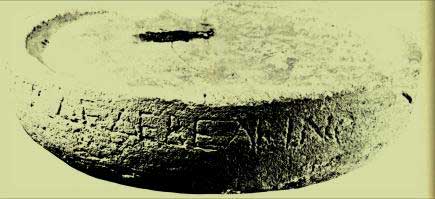
The unimaginable has to be richly imagined.
Pre-Christian traditions of a Grail stone that doubled as a
serving dish were drawn from
Celtic artifacts such as the Belenus "offering table." Like
Wolfram's Gral, it comes complete with writing around the rim.
From the nature of the second question, we can infer that Parzival
had a genuine mystical awakening in the presence of the Gral-Stone,
whatever it was, but the Lohengrin sequel does not derive from
this aspect of the Legend. Of the three
currents
that
proceed
from
the
Grail, one
goes outward into the world, in the direction of social enlightenment,
after the model of
Lohengrin.
This leads to Renaissance humanism. This is the noble philanthropic
current, the path of service through privilege, with the Buddhist
option of renouncing merit. It is the mundane, pragmatic,
socially oriented expression of indigenous magic — the exoterically
manifesting current from the Grail.
With Parzival's mystical realization, allowing him to pose
a question to the Gral-Stone itself, other developments
arise. Two other currents proceed from
direct encounter with the supreme numen of indigenous
magic. They are both deeply mystical and do not find expression
in social
life,
but
rather in anti-social trends, in esotericism, counterculture,
and underground movements that tend to assume a cryptic and cultic
character. Both of these currents deeply inform the plot of
alternative history. They emerge through historical events from
the 10th
century onward, but they originate in earlier times. Unlike the
social activist initiative represented by Lohengrin, which did
not exist before the 10th century, the other two currents have
an ancient provenance. But they come to a thriving expression
in a unique manner after the pivotal moment when Parzival attained
the Grail: 968 CE.
In parallel history, the reflections of these two currents
are the European cult of Amor and the Great
Work, the art of alchemy.
